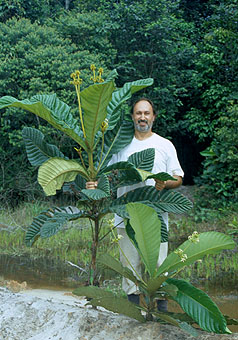Rubiaceae of the New World
By Piero Delprete and
Rocio Cortés
REMIJIA A. de Candolle
Rubiaceae of the New World
By Piero Delprete and
Rocio Cortés
REMIJIA A. de Candolle
|

Habit (with P. Delprete) |
Shrubs, small trees or medium-sized trees; raphides absent; axillary thorns absent. Stipules interpetiolar, free at base or connate at base, narrowly triangular, deltoid, broadly triangular, ovate, obovate, oblong or ligulate, subcaducous or readily caducous. Leaves opposite or whorled, 3 to 5 per node, long or short-petiolate; blades ovate, narrowly elliptic, elliptic, obovate, broadly obovate, oblong or oblanceolate; stiffly chartaceous, papyraceous, thinly or thickly coriaceous; foliar pellucid glands absent; domatia sparse or dense tufts of hairs or absent. Inflorescence axillary, paniculate densely or sparsely branched, cymose pauciflorous or multiflorous or thyrsoid. Flowers bisexual, protandrous. Calyx cup-shaped, with undulate margin or with small lobes, campanulate, short or long tubular, persistent; lobes absent (calyx truncate or undulate), 5 or 6, narrowly triangular, broadly triangular or lanceolate, absent, minute, small or long, aestivation valvate. Calycophylls absent. Corolla hypocrateriform, actinomorphic, white to cream-white; tube externally puberulent, pubescent, hirsute or sericeous; internally glabrous or pubescent at mouth; without a pubescent ring inside; orifice annular thickening absent; lobes 5 or 6, valvate, linear-lanceolate or linear, margin entire, acute at apex. Stamens alternate to the corolla lobes, included or partially exserted (only tips exserted); anthers narrowly elliptic, narrowly oblong, elongate or linear, round at base, round at apex, dehiscing by longitudinal slits, dorsifixed near the base; filaments attached at the middle of the corolla tube, free at base, slender, short (anthers subsessil) or long, shorter than corolla tube, equal, glabrous. Pollen colporate, apertures 3 or 4, exine surface foveolate, released as monads. Style partially exserted (only tips of branches exserted) or included, terete throughout, not fleshy, glabrous, antrorse-strigose, pubescent or setose-hirsute at basal portion; lobes 2, ovate, elliptic or oblong. Ovary inferior, 2-locular, obconical, ovoid or oblate; placentation axile, placenta peltate to the entire lenght of the septum; ovules many per locule. Fruit a septicidal capsule, dehiscing basipetally, the valves secondarily splitting at apex or septicidal capsule, dehiscing acropetally (rarely basipetally), thinly woody. Seeds horizontal, medium-sized to large, laterally compressed, irregularly elliptic in outline; wings bipolar, margin nearly entire, dentate or fimbriate.
Geographic distribution: Northern Chocó area, Magdalena-Llanos area, Napo-Marañón drainage, southwestern Amazon Basin, western Amazon Basin, Guayana Shield, central Amazon basin, eastern Amazon basin, Brazilian Atlantic coast, Brazilian planalto, northern Andes (above 1000 m) and extra-tropical South America.
Number of species: 41.
References: J. A. Steyermark, Remija, in Maguire &
collaborators, Fl. Guyana Highland, Mem. New York Bot. Gard. 23: 249-269.
1972; L. Andersson, Remija, Fl. Ecuador 62: 64-69. 1994.